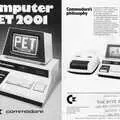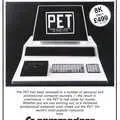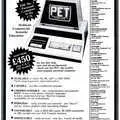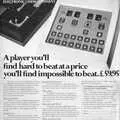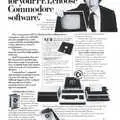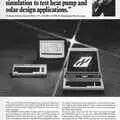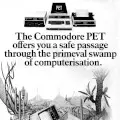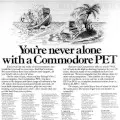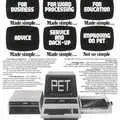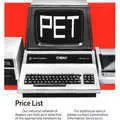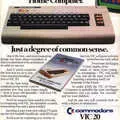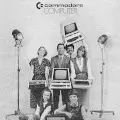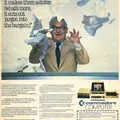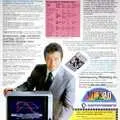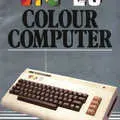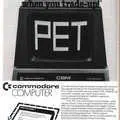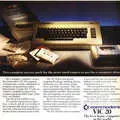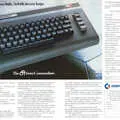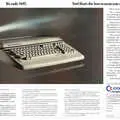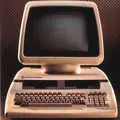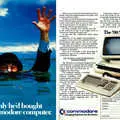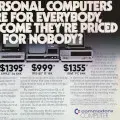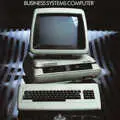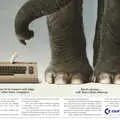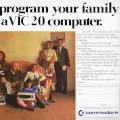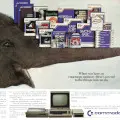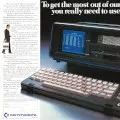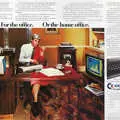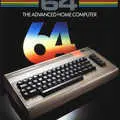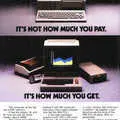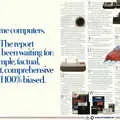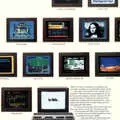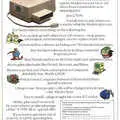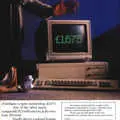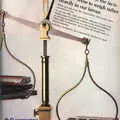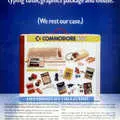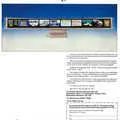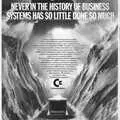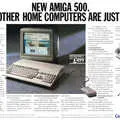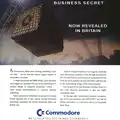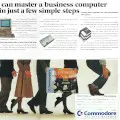
Commodore Advert - December 1986
From Personal Computer World
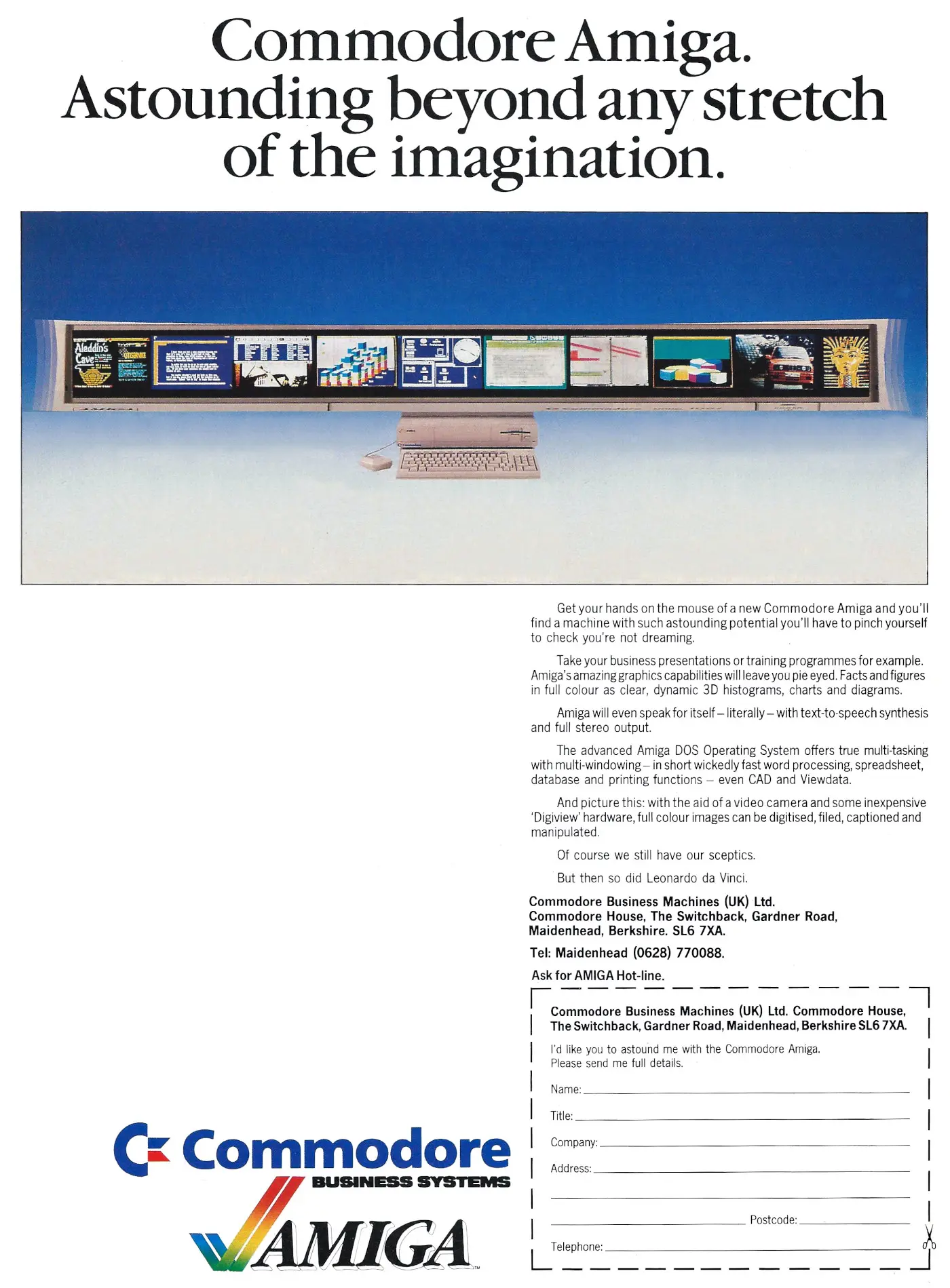
Commodore Amiga - astounding by any stretch of the imagination
The Amiga, code-named "Lorraine", was first demonstrated to a select few at June 1984's CES show in Chicago, by Amiga, a company founded by Jay Miner, one of the original designers of the famous Atari 2600 games console.
Amiga, formerly known as Hi-Toro, was known to have been looking for capital in order to finish its prototype machine and start production, but still surprised everyone with the announcement in August of the same year that Commodore had bought the company.
Commodore paid $25 million (about £68 million in 2025) in cash and stock for Amiga, in return for which it acquired 27 engineers as well as the rights to the Lorraine.
Commodore's own share price, which had recently fallen to below $20, recovered to $30 on news of the purchase[1], although it fell again when full details of the deal became public[2].
Meanwhile, Jack Tramiel, who had resigned from - or had been sacked by - Commodore on the 13th January 1984 following a bust-up with long-time financier and chairman Irving Gould over either Tramiel's nepotism or Gould's misuse of the Pet Jet, purchased the struggling Atari consumer division in July[3].
The company was renamed to Tramel Technology Limited - the missing "i" being a deliberate attempt to get the pronunciation roughly like that of his Polish birth name Idek Trzmiel[4].
Atari had been making huge losses for its parent Time Warner, and a sale had been on the cards for some time.
In a late attempt to get into shape, Atari had already been attempting to trim overheads, following rumours that MV Phillips was in the market to acquire a stake, and the Dutch company was said to be insisting on a "substantial trimming of the Atari payroll".
Perhaps with this in mind, Warner's president Steve Ross had already announced a stipping away of beaurocracy and a reduction in Atari middle management, with upwards of a 1,000 job losses[5] - a process which Tramiel was happy to continue, ending up with 9,000 staff removed from the head count[6].
As well as the rumours of a Phillips buy-out, it was even suggested in the press that Commodore itself had also been in the bidding for Atari "unaware that its former leading light was limbering up for combat"[7].
As part of the deal, previous owners Time-Warner transferred most of Atari's assets over to TTL in return for $240 million in notes at below market interest rates, all of which effectively meant that Tramiel had not paid any money but had just assumed Atari's debts. It was said that Warner "sold Atari to Jack and loaned him to money to buy it"[8].
When Tramiel left the company he had founded, he took with him his son Sam as well as several veteran Commodorians, including John Feagans, Tony Tokai, industrial designer Ira Velinsky and the man who had set up Commodore's buy-out of MOS Technology, Greg Pratt.
Meanwhile, whilst former Commodore employees were defecting to Atari, news was that Commodore itself had hired none other than US General Alexander Haig, former Vietnam veteran, secretary of state for Ronald Reagan, and a man who had worked for Kissinger and Nixon.
It was suggested by Commodore International's chairman Irving Gould that Haig's "experience and reputation will be helpful to us"[9].
Legal actions
Upon the news that Amiga had been purchased, Atari - which had previously invested $500,000 in Hi-Toro and had seen that investment apparently turn in to $25 million - filed a $100 million law suit against Amiga claiming that Atari had signed a contract the previous Autumn to get access to the custom chips [known as Agnus, Portia and Daphne] that made the Lorraine possible, a deal no longer possible as Commodore cancelled all outstanding contracts.
The lawsuit was due to come to a head in November 1986, when it came to trial in the US.
Despite Amiga/Hi-Toro having paid Atari's investment back, Tramiel was claiming that the contract had not been properly terminated, although Atari spokesman Claud Mahum was typically more reticent saying "We have a very good case, but our attorneys have advised us not to comment".
Jay Miner, meanwhile, was more direct, suggesting that "It's just harassment by Atari. I'm sure Atari will lose, so I don't know if there will be an appeal or not, but Atari seems to think the chips belong to them somehow"[10].
The whole thing had followed not long after another lawsuit which had been aimed at the group of engineers who had left Commodore in order to join Atari, claiming that they carried some of Commodore's trade secrets with them, in particular those surrounding the new Z8000-based computer project[11][12]
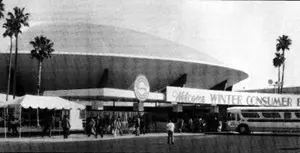
Winter CES, Las Vegas, 1986 © Commodore HorizonsThe original Amiga launched in 1985, initially targetted somewhat uncomfortably as a business machine - hence the advert coming from Commodore Business Systems.
There was disappointment though when it failed to make an appearance at June 85's Consumer Electronics Show, as Commodore was instead concentrating on the 8-bit C128 of which there were dozens on show, all the while fending of questions about "the computer they didn't want [people] to talk about".
The summer CES appeared to be something of a downbeat affair, at least for microcomputer companies, as the industry was going through something of a "purple patch". Ending up as a smaller show than the UK's Personal Computer World event, only three hardware companies were exhibiting, the other two being Amstrad and Atari.
Software companies were thin on the ground too, although Commodore User speculated that this was mostly because none of them had anything new to show, having reached the limits of hardware in the ageing range of 8-bit micros around at the time like Commodore's own C64.
However, Electronic Arts' Trip Hawkins - once director of marketing for Apple's personal office systems division[13] - still seemed broadly positive about the future, describing the summer CES as "the lull before the storm"[14].
Amiga appears as Commodore falters
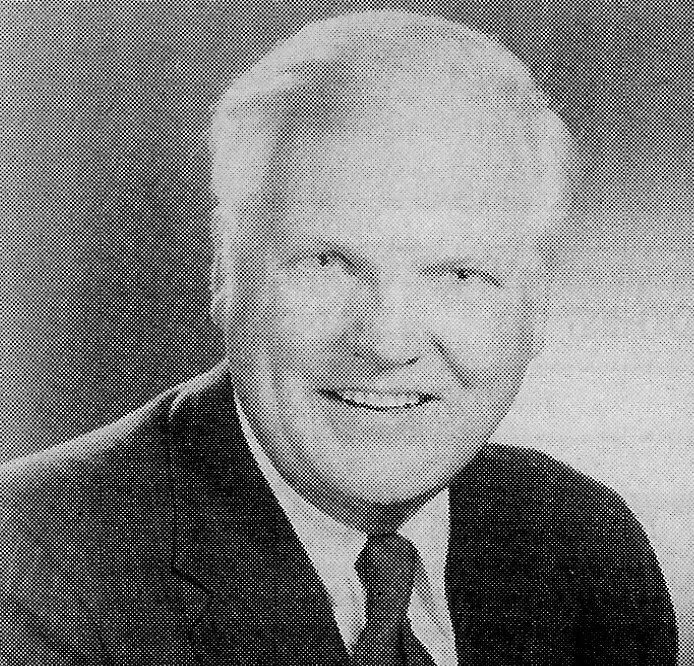
Marshall Smith, president of Commodore, © Popular Computing Weekly, 15th March 1984The Amiga did make a showing at the January 1986 Winter CES in Las Vegas but at a time of increasing financial problems for Commodore.
The company had racked up losses of $113 million (about £300 million in 2025) for the financial year ending 1985 on the back of tumbling sales as well as a $50 million stock writedown and the laying-off or 700 people - 15% of the workforce - at parent company Commodore International.
Hopes were riding high on the Amiga to bail the company out, however somewhat worryingly early sales in the US were "at the low end" of the company's forecasts[15] with the cheaper Atari 520ST giving the machine "a run for its money".
In October of 1985, Commodore hit the road in a 40-city tour of the US in an effort to drum up support for the Amiga amongst dealers - by August of that year only 260 dealers has so far signed up to sell the machine, although Commodore was saying that several deals with major chains "were imminent".
Commodore seemed to be on the back foot about the "technically dazzling" Amiga, with David Ahl summing up "will the Amiga save Commodore? Not with marketing like this"[16].
Atari was also at CES and was comparing its ST to the Amiga by running versions of the Amiga's already-famous bouncing ball demo.
However, it didn't reveal that whilst the demo on the Amiga was complete with sound and took minimal software scrolling to achieve, the equivalent demo on the ST was silent and required "huge amounts of processing power".
When asked about the ST in an interview published in August 1985's Commodore User, president Marshall Smith said:
"There is just no comparison. Anybody can pick up a Motorola chip for $8 and build a computer around it, but it can't do half the things the Amiga can. [The ST] can't multi-task; the sound, colour and graphics on the Amiga are better in every respect".
Despite that, Smith was quick to point out "I never dismiss competitors - any time I've done that before I've lived to regret it"[17].
A big problem that Commodore had was that although it wanted to sell the Amiga through dealers, it had burnt its dealer bridges back in 1982 when it had launched the 64.
Although initially sold through regular computer shops, as soon as the 64 became successful Commodore started selling it through discount stores at a massively-reduced price, leaving computer stores with machines they could only sell at a loss.
As a result, independent computer dealers in the US hated Commodore. The big three chains in the US - Computer Land, Businessland and Entre - announced that they wouldn't be selling the Amiga, and Commodore's previously-favoured discount chains couldn't really sell it as nobody buys $1,295 machines in K-Mart or Poundland.
That left a few smaller chains, but even here only The Computer Factory of New York and Computone of Atlanta had signed up by the Autumn of 1985.
Even if dealers didn't hate them, there was still the problem of over-crowding in the market and the fight for shelf space with the IBMs and Ataris already out there.
And if that wasn't bad enough, there was also the worry over Commodore's finances, the general slump in the industry and even a perception that - like Sinclair in the UK - the company's computers were perhaps aimed at the "toy" end of the market, which was a particularly problematic view as the Amiga was originally pitched as a business machine.
Dan Gutman of Commodore User pointed out that the company was obviously worried enough about this to leave its name off the front of the machine[18].
Invisible Amiga
By the beginning of 1986 there was still no sign of the Amiga in the UK, other than a rumoured 80 or so machines that had been imported for use by software houses.
That compared with 400 Amigas sent to US software houses with a further 700 receiving technical specs, whilst 70,000 machines had actually shipped by the end of 1985, although it was said that on account of the general lack of software that sales were mostly to hackers and software developers.
Commodore's new president Thomas Rattigan was at least being straight up about the problems, telling InfoWorld that "[the Amiga's] not coming as rapidly as we would have liked to have seen it come", whilst VP of sales Frank Leonardi was toeing the more usual Commodore line of over-optimistic promises by stating that there would be 100 Amiga programs by March 1986[19].
Commodore further disappointed UK fans, who had been expecting the machine at the beginning of 1986, by announcing that the Amiga wouldn't be available in quantity until June, with some more limited quantities of NTSC-standard being made available in March.
It was also still undecided where the UK PAL version of the Amiga would be assembled, with Commodore User speculating that "by the time it rolls off the assembly line the remarkable enthusiasm it continues to generate may be going stale"[20].
It was perhaps lucky that it was late, as otherwise it might have had a trademark struggle with the Amigo, a Z80A-based micro from Optim Computers which was released at the beginning of 1983[21].
Luckily for Commodore, this throwback machine had clearly dropped off the face of the earth by the time the Amiga made its delayed debut.
Metacomco gets the gig
The UK had a particular interest in the software of the Amiga, as when it became clear that Microsoft's port of its own Basic wouldn't be ready in time, Bristol-based Metacomco was approached to provide the AmigaDOS operating system and ABasic instead.
The company, which had previously licenced its 8086 Basic interpreter for $800,000 (about £2,413,900 in 2025) to Digital Research, had also been quietly writing system software for the Moto 68000, but was not otherwise famous - Metacomco's Tim King said "We're trying very hard to get people to know who we are".
Metacomco seemed as surprised as anyone to get the gig, as even though it had a nominal office in Monterey, California, the company was tiny.
Metacomco's marketing manager Peter Mackeonis recounted how "some Amiga people came to our stand at Las Vegas CES in 1984 and asked if we did anything on operating systems. Four months later they rang up and asked for a list of our ideas for a new machine".
The company had won the contract only six months before the Amiga's US launch, but conveniently had something of a headstart as it already had a suitable single-user multi-tasking operating system in the form of Tripos, which had been developed at Cambridge University in the late 1960s.
It had also already ported two of its Tripos languages - an Assembler and BCPL (the forerunner of C) - to the Sinclair QL, a 68008-based micro.
Nevertheless, producing an entire operating system for a new machine in only six months was certainly a tall order. Metacomco's King, who had overseen the entire Operation Amiga from the beginning, said of the effort that:
"It was really hard work [and] I know at least three members of the Amiga team with camp-beds in their office. They even work weekends"[22].
King himself spent a lot of the time in a three-week rotation between Bristol, Monterey, Commodore's HQ in Pennsylvania and Amiga on the West Coast of the US.
Pam Clare, Metacomco's technical manager added:
"While our AmigaDOS is certainly adapted from Tripos, we have had to do a lot of modifications to make it acceptable for a modern system. We've had to customise it to make the best use of the Amiga's graphics and sound capabilities - getting it to address the Amiga's custom chips has been the major modification".
The company was not hanging around with other deals, as it was about to launch a version of C for the QL at the September Personal Computer World show, and as well as selling its existing versions of Assembler, BCPL, Lisp and Pascal for the QL it was also on the cusp of launching software for the Atari ST.
However, it had ruled out the Apple Mac, launched the year before, as it considered its links with Digital Research to be more fruitfull.
Mackeonis said "I would like to see Metacomco become a major force in the market place - the new Digital Research if you like, but home grown".
Metacomco also saw its AmigaDOS as a "pre-Unix system" and intended to licence it to other micro manufacturers, with Mackeonis continuing:
"It's certainly a strong contender for the 'windows market'. As yet there is no standard operating system for the 68000 chip, so it would be good if we can get Tripos going now"[23].
Meanwhile, Bing Gordon of Electronic Arts, a software company that had spent $1 million on developing for the Amiga by April 1986[24] expressed some concern over the state of Commodore, pointing out that:
"Atari's Jack Tramiel has shown himself to be pretty canny, while Commodore has made lots of mistakes recently".
After Commodore held a press conference on the opening day of the Las Vegas CES, and then disappeared for the rest of the show, Commodore Horizons' CES report went on the suggest that
"the failure to show the Amiga properly at CES and the continuing scepticism of software suppliers towards the market hopes of the expensive Amiga mean that Commodore's machine is in for a rough ride"[25].
The sentiment over in the UK was similar, with the excitement over the original specifications giving way to gloom, with software problems looming large.
To be fair, these had been expected by Commodore which was why it shipped all its early software for the Amiga on disk instead of in ROM.
What seemed more problematic was that the Amiga didn't seem to be making much of an impression of software houses. Dave Winer of software company Living Videotext said of his company's attempts to port ThinkTank to the Amiga that:
"They've given us a development machine which doesn't work and left us. When Apple first gave us a Macintosh, that didn't work either, but they also gave us five engineers. We're not getting that help with the Amiga problems".
Apple, meanwhile, had just cut the price of its Macintosh, adding to the uncertainty for small software companies over which machine to support[26].
Even as late as August 1985, the Amiga still had only one official application package ready - a word processor known as TextCraft. There was no other application software yet available and the machine's Basic was not yet finished, although Metacomco's 68000 development tools - a linker, assembler and editor - were being shipped in ROM.
Luckily for Commodore, arch-rival Atari was not doing much better with its software for the ST - it had a grand total of two packages available: GemWrite and GemPaint[27].
Rave reviews
In spite of all the software shortages, there were rave reviews in the press, inluding Guy Kewney writing in August 1985's Personal Computer World where he stated "come the revolution, there's going to be a definitive micro - low cost, multi-tasking and the last word in business computing. Commodore's Amiga may be it". He continued:
"this really is the micro I've been waiting two years for the world to produce. This is the business machine which any games programmer would give his eye-teeth to get hold of. This is the games machine which business software writers will be able to really make hum. And this is the machine which users will really love"[28].
There was something of a comedown a few months later, following the three-day Amiga Developers' Conference in Eastbourne, where some realities of the Amiga were revealed, including the fact that its multi-tasking operating system wouldn't protect multiple programs from each other; the cutting-edge "bit blitter" - used for moving around huge amounts of data super-fast - would only work on video memory, and peripheral development looked to be moving too slowly.
The current financial state of Commodore was also causing waves, with developers and suppliers nervous that the company might even go bankrupt, and there was even fear amongst the corridors of Commodore itself.
One senior Commodorian was said to have said "Don't tell anyone I told you this, but if you know anybody with a few million to spend, try to persuade them what a good investment Amiga would be".
The situation was bad enough that Commodore had already defaulted on some bank loans and was busy re-scheduling others, although it believed it would get back in the black over the Christmas period.
Much of that hope rested on the venerable 64 and its sort-of upgrade the 128. Production of the Amiga, which might properly make a difference, was running at about a quarter the output of Atari's 520ST, where it really needed about ten times the output.
Another senior executive said:
"We have to decide where our heart is. We have to decide whether we are pushing this machine out in to the market place, with all the resources it needs to be a success, or whether we are trying to be respectable. I think that at the moment, our bankers wouldn't dare to make us bankrupt and we should use our revenues to do what has to be done to the machine. We should not sacrifice the machine, we should not simply concentrate on paying off debts until they feel that they can bankrupt us safely".
Guy Kewney concluded his revised analysis by saying "It remains the machine which I've been waiting for, even though I've had to trim my dreams a bit to suit"[29].
Antony Jacobson, editor of the normally partisan Commodore Computing International also weighed in in the magazine's June 1986 issue by saying:
"Commodore is surely staking its corporate future on this technically exciting but commercially risky computer. People are waiting for the Amiga to take off and, in effect, [are] waiting for a decision on Commodore's future. For [the Amiga] to succeed in the UK and around the globe will require a return of what used to be Commodore's great strength - marketing - giving the public something they want, something they feel they need at a price they are willing to pay and promoting, advertising and selling it in a fiercely competitive market. The Amiga alone is not enough, the question is whether Commodore still has the corporate will and can commit the resources"[30].
Minter's Metagalactic Llamas
As well as the Atari ST and threats of "Amiga killers" like JVC's rumoured MSX2-based HC95 - cheaper than the Amiga at £1,000 but with the capability to also mix digitised video and computer graphics freely[31] - The IBM PC was also a potential problem. This led Chris Kaday - Commodore's marketing director - to state:
"it is therefore all the more ironic that the current obsession with standards, coupled with widespread reticence to adopt new technology, seriously hampers the successful introduction of a new computer".
As a sop towards the competition, the Amiga also offered an MS DOS emulator - or an IBMulator as Practical Computing called it - running on an plug-in module known as Sidecar and which was first revealed in the UK at the PC User Show in Olympia in July 1986[32].
It contained an 8088 CPU, a 5¼" floppy disk drive and three full-sized expansion slots. Internally it was said to be similar to Commodore's own PC-10 IBM clone.
Unlike some other external processors, like Torch's Z80 box for the BBC Mico, Sidecar didn't simply use the host machine as a fancy display and keyboard.
Instead, it was a genuine co-processor, meaning the Amiga could actually run DOS programs as just another task in an Amiga window, with other Amiga programs running normally. Sadly though it didn't work the other way as it couldn't provide access to the Amiga's cooler features to the DOS environment.

Jeff Minter, © Your Computer December 1987It wasn't cheap though, with its price at launch hoped to be "considerably less than $1000". Whilst Practical Computing suggested that "technically, Sidecar is a wonderful product", it also said that its very existence "underlines the shortage of Amiga business software"[33].
Others in the press were less enthusiastic, with Commodore User suggesting that the whole "trying to emulate the IBM PC" situation was simply "dumb"[34].
Kaday went on to point out that ensuring there was enough software around early on was a priority but that:
"The Amiga has got off to an excellent start with a wide range of utilities, horizontal and vertical market applications already nearing completion"[35].
This software wasn't yet "out there" but it did look promising, prompting Jeff Minter, legendary software developer, owner of Llamasoft and writer of perhaps the best-named game ever - "Metagalactic Llamas Battle at the Edge of Time" - to comment:
"Hopefully the current lack of Amiga stuff shouldn't last long, and some of the stuff in development looks like it's gonna blow minds. Pity the Amiga's just so damn expensive"[36].
It wasn't until early 1986 that software started appearing in serious amounts, with seven third-party software houses announcing new products for the machine. These included Chang Labs, Lattice Software, Island Graphics - an early support of the Amiga - and Maxisoft, with a range of packages from accountancy to graphics and painting.
Commodore was also marketing Chang Labs' Rags to Riches package, as well as Metacomco's own Pascal, Lisp and Assembler programming tools. The company was also claiming that as of January 1986 over 900 developers had received Amiga Development Kits, and that 150 more software packages were being launched during the first half of the year[37].
Once software did become available, it was clearly in demand if a lorry heist in France was anything to go by, when Software house Psygnosis confirmed that a "large consignment" of the Amiga version of the game "Blood Money" had been hijacked on its way to Paris.
The lorry was also carrying clocks and lighters, but these were left behind, untouched[38].
---
Before switching allegiance to the Atari ST, Minter was a Commodore fan and had developed his first game in 1979 on a Commodore PET whilst at 6th-form college. He swiftly moved on the the VIC-20 because "It was cheap and it had colour".
Minter then fell ill with a virus infection and spent the next few months lying on his back in bed, a situation which he turned to his advantage to spend time learning to program.
He never returned to his college course in maths and computing and decided to continue with his programming venture, which proved to be a good move as by the May of 1983 Minter's Llamasoft had gone from £15-£20 a week to £5,000 a week in sales, which - as Minter said - "for a one-man operation is really nuts"[39].
Date created: 22 February 2019
Last updated: 11 December 2024
Hint: use left and right cursor keys to navigate between adverts.
Sources
Text and otherwise-uncredited photos © nosher.net 2025. Dollar/GBP conversions, where used, assume $1.50 to £1. "Now" prices are calculated dynamically using average RPI per year.

